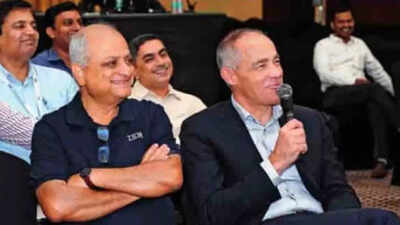ARTICLE AD BOX

Ric Lewis (with mic), senior VP in IBM Infrastructure, says every time he visits India, he leaves super-energised because employees here are so excited, pumped up. “They’re doing deep software, hardware design. And they are so excited about the stuff they are building, I can’t wait for the clients to see it,” he says. Here he’s with Akhtar Ali, VP in IBM Systems, and others at a conference in Bengaluru
Ric Lewis tells us he’s on a jet lag schedule, but he’s not tired at all. Because all of the excitement of his India teams, and the innovations that he’s seen the teams do, he says, is just so invigorating.For IBM’s head of infrastructure, the India centre has become central to all of his five businesses – mainframes, Power servers, storage, cloud and customer support. Mainframes! You might wonder what anyone could still be doing there! The reality is, there isn’t probably work that’s more exciting.Ever since the client-server era, and more so since the cloud era, we barely hear of mainframes. But on your banking app that’s running on a public cloud, if you ask for your balance, or you move money, there’s a more than 70% chance that the app has to send a message to a mainframe to obtain the information or conduct the transaction. Because some 7080% of the world’s transaction data still reside on mainframes. It’s similar or more for credit card transactions.Banks, airlines, hospitals, govt, and even retail, many still use mainframes for their most critical applications and data, because almost nothing can still match their resilience, security, uptime, and processing capacity.
IBM – which pioneered mainframes and now has an overwhelming share of that market – has over the years worked to ensure mainframes can easily interoperate with cloud, as enterprises moved to a
hybrid-cloud strategy
. And more recently, it has brought in powerful AI features. AI, Lewis says, is built into the mainframe chip. The previous version of the chip could use AI to do basic fraud detection in realtime. The latest mainframe version launched earlier this year brings in GenAI capabilities too. This means, Lewis says, the system can in real-time not only look at anomalies in transactions (like payments made in two very different geographic locations within a short span), but also check if the company to whom money is being transferred has a registered address, whether it has a good reputation based on public reviews.Insurance companies can check what’s been happening to a certain kind of insurance policy in a certain region instantly, and figure out, for instance, if they should raise premiums.AI in the mainframe also helps with managing the entire computing system. “We have built in something to do inference on optimal configuration of the system, and security parameter settings,” Lewis says.AI has been used to help employees in the support services organisation, as also automate some of the support processes. Customers can now ask a chatbot questions like: “I saw the following behaviour in this system. Tell me what you think is wrong with it.”India's roleA lot of the software/hardware work that’s happening with mainframes and Power servers is happening in India. “We’re doing full architecture to implementation, to delivery, to test, to follow up and support. So it’s a really critical place for us,” Lewis says.Looks like all of this work is really paying off. IBM’s share price has risen 60% in the past year, and 120% in the past two years. That’s phenomenal recovery for a company that was struggling for many years prior to this.



.png)
.png)
.png)
















 1 day ago
7
1 day ago
7









 English (US) ·
English (US) ·